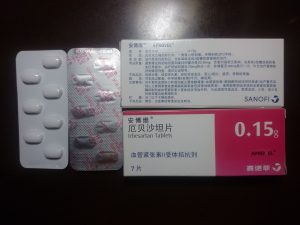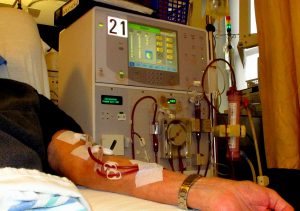“A Controlled Trial of Renal Denervation for Resistant Hypertension”
N Engl J Med. 2014 Apr 10;370(15):1393-401. [free full text]
—
Approximately 10% of patients with hypertension have resistant hypertension (SBP > 140 despite adherence to three maximally tolerated doses of antihypertensives, including a diuretic). Evidence suggests that the sympathetic nervous system plays a large role in such cases, so catheter-based radiofrequency ablation of the renal arteries (renal denervation therapy) was developed as a potential treatment for resistant HTN. The 2010 SYMPLICITY HTN-2 trial was a small (n = 106), non-blinded, randomized trial of renal denervation vs. continued care with oral antihypertensives that demonstrated a remarkable 30-mmHg greater decrease in SBP with renal denervation. Thus the 2014 SYMPLICITY HTN-3 trial was designed to evaluate the efficacy of renal denervation in a single-blinded trial with a sham-procedure control group.
The trial enrolled adults with resistant HTN with SBP ≥ 160 despite adherence to 3+ maximized antihypertensive drug classes, including a diuretic. (Pertinent exclusion criteria included secondary hypertension, renal artery stenosis > 50%, prior renal artery intervention.) Patients were randomized to either renal denervation with the Symplicity (Medtronic) radioablation catheter or to renal angiography only (sham procedure). The primary outcome was the mean change in office systolic BP from baseline at 6 months. (The examiner was blinded to intervention.) The secondary outcome was the change in mean 24-hour ambulatory SBP at 6 months. The primary safety endpoint was a composite of death, ESRD, embolic event with end-organ damage, renal artery or other vascular complication, hypertensive crisis within 30 days, or new renal artery stenosis of > 70%.
535 patients were randomized. On average, patients were receiving five antihypertensive medications. There was no significant difference in reduction of SBP between the two groups at 6 months. ∆SBP was -14.13 ± 23.93 mmHg in the denervation group vs. -11.74 ± 25.94 mmHg in the sham-procedure group for a between-group difference of -2.39 mmHg (95% CI -6.89 to 2.12, p = 0.26 with a superiority margin of 5 mmHg). The change in 24-hour ambulatory SBP at 6 months was -6.75 ± 15.11 mmHg in the denervation group vs. -4.79 ± 17.25 mmHg in the sham-procedure group for a between-group difference of -1.96 mmHg (95% CI -4.97 to 1.06, p = 0.98 with a superiority margin of 2 mmHg). There was no significant difference in the prevalence of the composite safety endpoint at 6 months with 4.0% of the denervation group and 5.8% of the sham-procedure group reaching the endpoint (percentage-point difference of -1.9, 95% CI -6.0 to 2.2).
In patients with resistant hypertension, renal denervation therapy provided no reduction in SBP at 6-month follow-up relative to a sham procedure.
This trial was an astounding failure for Medtronic and its Symplicity renal denervation radioablation catheter. The magnitude of the difference in results between the non-blinded, no-sham-procedure SYMPLICITY HTN-2 trial and this patient-blinded, sham-procedure-controlled trial is likely a product of 1) a marked placebo effect of procedural intervention, 2) Hawthorne effect in the non-blinded trial, and 3) regression toward the mean (patients were enrolled based on unusually high BP readings that over the course of the trial declined to reflect a lower true baseline).
Currently, there is no role for renal denervation therapy in the treatment of resistant HTN. However, despite the results of SYMPLICITY HTN-3, additional trials have since been conducted that assess the utility of renal denervation in patients with HTN not classified as resistant. SPYRAL HTN-ON MED demonstrated a benefit of renal denervation beyond that of a sham procedure (7.4 mmHg lower relative difference of SBP on 24hr ambulatory monitoring) in the continued presence of baseline antihypertensives. RADIANCE HTN-SOLO demonstrated a 6.3 mmHg greater reduction in daytime ambulatory SBP among ablated patients than that of sham-treatment patients notably after a 4-week discontinuation of up to two home antihypertensives. However, despite these two recent trials, the standard of care for the treatment of non-resistant HTN remains our affordable and safe default of multiple pharmacologic agents as well as lifestyle interventions.
Further Reading/References:
1. NephJC, SYMPLICITY HTN-3
2. UpToDate, “Treatment of resistant hypertension,” heading “Renal nerve denervation”
Summary by Duncan F. Moore, MD


